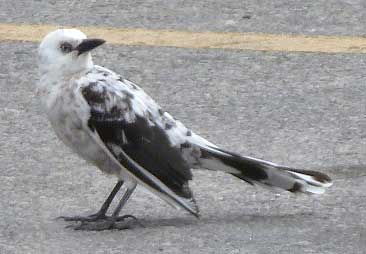Excerpts from Jim Conrad's
Naturalist Newsletter
from the February 17, 2013 Newsletter issued from the valley of the Dry Frio River in northern Uvalde County, southwestern Texas, on the southern border of the Edwards Plateau; elevation ~1750m (~5750 ft); N29.62°, W99.86°; USA
AN ALMOST WHITE BLACKBIRD

The other day my neighbor Fred was in downtown Uvalde south of here when he came upon a small flock of blackbirds on a street, and one of the birds was mottled black and white as shown above.
Fred assumed that the birds were Great-tailed Grackles, which are abundant in town, but the tail and beak of our speckled bird aren't long enough to be that, nor even the smaller Common Grackle. I was unsure who it might be so I sent the picture to my old birding buddy Jarvis in North Carolina who is PHD'd in ornithology. Jarvis suggests that it's a Brewer's Blackbird, pointing out the pale eye, which distinguishes it from a Red-winged Blackbird, and the fact that Brewer's Blackbirds are known to be abundant in our area, in fields, around ranches and along roadsides.
When you see an animal patterned like this bird you think "partial albino." However, when you look into the matter on the Internet you find other options. Most photos similar to ours and posted by people who ought to know their business label such birds as "leucistic."
Leucism is different from albinism in that albinism results from the absence of the pigment melanin, while leucism comes about when all pigments are missing, not just melanin. Thus in species whose colors are produced by a variety of pigments albinos are not entirely white, but rather pale yellow. Leucistic individuals, in contrast, are entirely white or at least their leucistic parts are pure white.
Partial leucism like that shown in Fred's bird produces what is known as a "pied" or "piebald" effect. Piebaldness is especially common among domestic animals -- horses, cows, cats, dogs -- as well as Crows who hang around urban areas. Since the effect occurs mostly among domesticated and semidomesticated animals, it should be no surprise to see a piebald Brewer's Blackbird, since that species has adapted so well to human environments.
Why does piebaldness mostly occur among domesticated or semidomesticated animals? One way to think about it is that around humans piebald individuals are less likely to be noticed by predators than in the wild, so they end up passing their genetic malfunction causing leucism to their offspring.
from the December 1, 2002 Newsletter issued from the woods just south of Natchez, Mississippi, USA
BREWER'S BLACKBIRD AT BREAKFAST
Earlier in the week a morning had broken overcast, so that day's feeling was completely different from the golden ones. That morning during breakfast a diffuse cloud of blackbirds moved through the treetops surrounding my camp. It was a mixed flock with a lot of Grackles and some shorter-tailed blackbirds. Mixed flocks like this in our area often consist not only of Grackles but also Red-winged Blackbirds, Brewer's Blackbirds, the occasional Brown-headed Cowbirds, and I'm just not sure if Rusty Blackbirds sometimes join in.
A Brewer's Blackbird flew into the big Pecan tree right above my outside kitchen carrying something in his beak. The binoculars showed his meal to be nothing less than a limp little Green Anole, held by the neck so that his head drooped down, making the silhouette of his long-tailed body look like an upside-down J. The anole's four legs spraddled helplessly, the toes on each foot spread like the points of a star, and it was a pitiful thing to see.
I can't imagine how this bird captured a Green Anole so early in the morning, for the sun wasn't high enough for anoles to come out and bask in its rays. Whatever happened, now the blackbird beat the creature against the branch and flipped the body around and around, trying to get it in position so that it would slip down his gullet smoothly. However, maybe the anole was just too large because after five minutes the bird flew off to catch up with his flock, with the reptile still dangling from his beak.
On the one hand, I have to admire the vigor of these blackbirds as they just take over an area for a while. Their big flocks passing around me are like the Mongol hoards on half-wild horses surging irrepressibly across the Central Asian plains. On the other hand, it seems a shame for such a common bird who usually is content with a grain of corn to eat such a complex and neighborly creature as an anole. If a bird must eat my anoles, I'd rather an owl or a hawk do it, snatching it after a brilliant dive from the sky.
Distinguishing the various blackbird species isn't always easy. The Brewer's Blackbird is very similar to the Rusty Blackbird. However, the male Brewer's head shines with a purplish iridescence, while the Rusty's doesn't, and that morning the anole-eater's head shined with iridescence. The distribution map in my birding field guide places us so close to the Brewer's' eastern limit that I was a little insecure about naming the bird. However, on the Internet I found updated maps showing that this part of the country is actually a "Brewer's hotspot." These maps are wonderful and if you identify birds you should bookmark the site. The USGS Patuxent Bird Identification InfoCenter is found at www.mbr-pwrc.usgs.gov/id/framlst/infocenter.html, and the Brewer's distribution map is at www.mbr-pwrc.usgs.gov/id/framlst/CBCMap/ra5100.gif.